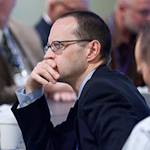Two TK operations represent the current progress and future development of ring-rolling processes
A new ring mill has started up at Rotek Inc., Aurora, OH, setting in motion a new wave of operations for forming and finishing rolled rings. It will be followed by more new installations in the coming months, including some new forming concepts. Rolled rings are perhaps the pinnacle of precision in high-volume forming, demonstrating accuracy as well as consistency, along with the value of highly engineered components. Rolled rings find a home in turbofan engines as well as cranes and heavy-duty equipment, and in the critical structures like bridges, offshore platforms, and oil-and-gas pipelines.
The Rotek project is part of previously unreported, multimillion-dollar expansion involving a new, SMS-built RAW 200/260 machine. The plant’s current capabilities for rolled rings covers the range from 15 to 155 in. OD, and the new machine’s products are described as “midsize diameter” rings. Typical applications for these products are offshore platforms, pipelines, large crane structures, and tool and die machinery. “By strengthening our capabilities in this critical diameter range, we are better able to provide faster delivery times to customers in the construction equipment as well as oil and gas markets which are vital to our business,” stated Mark Girman, CEO of Thyssenkrupp Rotek.
Rotek is an operating unit of Thyssenkrupp and one of North America’s largest manufacturers of slewing bearings, including ball and roller slewing bearings and wire-race slewing bearings. Another Thyssenkrupp business, Rothe Erde GmbH, recently ordered a new upsetting and piercing press for ring blanks from Siempelkamp, to be installed at its Dortmund Works in Germany. Siempelkamp indicated the machinery would be delivered to the plant site and installed during summer and fall 2017, with start-up forecast for January 2018.
No value was announced for the new project.
Rothe Erde is the world’s largest producer of slewing bearings — the rotating elements installed in large machines like cranes or windmills, to effect slow movement of heavy loads, often in a horizontal plane. The company also is a large-volume producer of seamless rolled rings, turntables, and structural elements.
The highly automated, 6,000-mt (est. 60 MN) press is planned to 4,000-mt press to produce ring blanks weighing 400 kg to 25 mt, in diameters up to 2,500 mm and heights of up to 830 mm. It will supply ring banks a ring-rolling mill already in operation at the Dortmund Works, and the higher press force capability will allow Rothe Erde to produce larger ring blanks in higher-strength materials.
Siempelkamp will be responsible for the entire installation (including peripherals) and process design. The press will feature two swivel arms equipped with hydraulically actuated removal devices. As such, it will be not be necessary to use fluxes (e.g., charcoal), so that there will be no undesired carburization of the pressed parts. Notably, dust emissions at the press will be minimized, too.
Siempelkamp also will supply service cranes for changing the press punch and will integrate a robotic manipulator to the control system. The manipulator will load the ingots into the press.
The cooling and lubrication system for the pre-punching tool are included with the overall supply.









